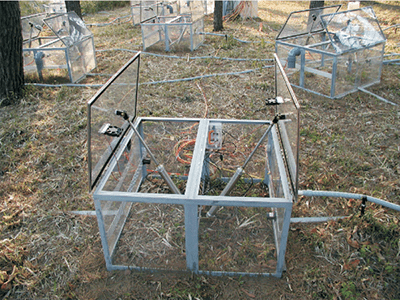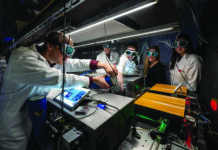
Measuring forest soil carbon flux gives an insight into the health of forest ecosystems and provides feedback on the effects of global warming. Edinburgh Sensors discusses how soil CO2 efflux can be determined and the applications of soil carbon flux research.
The Earth’s carbon cycle maintains a steady balance of carbon in the atmosphere that supports plant and animal life. In recent years, concerns about the increasing levels of CO2 in the atmosphere, indicating a problem in Earth’s carbon cycle, has been a prominent global issue.[1,2]
As a part of a stable carbon cycle, carbon is exchanged between carbon pools including the atmosphere, the ocean, the land and living things in a process known as carbon flux. Carbon exchange typically takes place as a result of a variety of natural processes including respiration, photosynthesis, and decomposition.
Since the industrial age, humans have begun to contribute to carbon exchange with activities such as fuel burning, and chemical processes, which are believed to be responsible for increasing atmospheric CO2 concentrations and increasing global temperatures.[1-3]
Soil carbon flux provides feedback on environmental conditions
Soil is a vital aspect of the Earth’s carbon cycle, containing almost three times more carbon than the Earth’s atmosphere. Carbon is present in soil as ‘solid organic carbon’ including decomposing plant and animal matter. Over time, microbial decomposition of the organic components of soil releases carbon into the atmosphere as CO2.[4,5]
The amount of carbon present in soil affects soil fertility, plant growth, microbial activity, and water quality. Studying the carbon flux of soil gives an insight into an ecosystem as a whole and specific information about microbial activity and plant growth.[4-6]
Soil carbon flux can also help us to understand and predict the effects of global warming. As global temperatures increase, is it expected that microbial activity will also increase, resulting in faster plant decomposition and increased CO2 efflux into the atmosphere.[5,6]
Measuring soil CO2 efflux
Determining soil-surface CO2 efflux can be challenging. Researchers commonly employ a chamber combined with CO2 concentration measurements to determine CO2 efflux. A variety of chambers have been designed for such research, some of which are commercially available.[7-10]
Closed-chamber systems typically pump air through a gas analyzer, which measures CO2 concentration, before returning the air to the chamber. Soil CO2 efflux is then estimated from the rate of increase of CO2 concentration in the chamber.
Open-chambers pump ambient air into the chamber and measure the change in CO2 concentration between the air entering the chamber and the air leaving the chamber to determine the soil CO2 efflux.
Of the two chamber types, open chambers are considered more accurate. Closed chambers tend to underestimate CO2 efflux as increased CO2 concentrations in the chamber cause less CO2 to diffuse out of the soil while the chamber is in place.[10,11]
Often, CO2 concentrations in chambers are measured periodically and then extrapolated to give an estimation of CO2 efflux. This method can be inaccurate because CO2 efflux can vary significantly between measurements with changes in environmental conditions.
A further limitation of using chambers for CO2 efflux measurements is that chambers typically only provide measurements in one location, while CO2 efflux has been found to vary widely even in relatively homogeneous environments. The overall result is CO2 efflux data with limited temporal and spatial resolution, that does not reflect the environmental situation as a whole.[10,12,13]
A group of researchers from the National Institute for Environmental Studies led by Naishen Liang has designed an automated, multi-chamber chamber system for measuring soil-surface CO2 efflux.
As CO2 concentrations are measured automatically using an infrared gas sensor, CO2 efflux can be determined accurately throughout the experiment. The improved temporal resolution, combined with increased spatial detail resulting from the use of multiple chambers gives a better overview of how CO2 efflux varies with time, location, and environmental conditions within an ecosystem.[10]
Liang and his team have applied his method to gather information about a range of forest ecosystems. Their automated chambers have been used in a variety of forest locations combined with heat lamps to provide high-resolution, long-term data about the effects of warming on microbial activity and CO2 efflux.
Liang’s research has shown that soil temperatures have a significant effect on CO2 efflux in a wide range of forest environments, information that is vital for understanding how global warming will affect forest ecosystems and the Earth’s carbon cycle as a whole.14-17
All chamber systems for determining CO2 efflux rely on accurate CO2 concentration analysis. Infrared gas analyzers are the most widely used method of instrumentation for determining CO2 concentrations in soil CO2 efflux measurement chambers.8,10,18
Infrared gas sensors, such as gascard sensors from Edinburgh Sensors, are well suited to providing CO2 concentration measurements in soil chambers, and are the sensors of choice used by Liang and his team.
The gascard sensors are robust, low-maintenance, and easy to use compared with other sensors. They provide rapid easy-to-interpret results and can be supplied as either complete boxed sensors (the Boxed Gascard) or as individual sensors (the Gascard NG) for easy integration into automated chambers.19,20
References and further reading
1. ‘The Carbon Cycle’
https://earthobservatory.nasa.gov/Features/CarbonCycle
2. ‘Global Carbon Cycle and Climate Change’ — Kondratyev KY, Krapivin VF, Varotsos CA, Springer Science & Business Media, 2003.
3. ‘Land Use and the Carbon Cycle: Advances in Integrated Science, Management, and Policy’ — Brown DG, Robinson DT, French NHF, Reed BC, Cambridge University Press, 2013.
4. ‘Soil organic matter and soil function – Review of the literature and underlying data’ — Murphy BW, Department of Environment and Energy, 2014
5. ‘The whole-soil carbon flux in response to warming’ — Hicks Pries CE, Castanha C, Porras RC, Torn MS, Science, 2017.
6. ‘Temperature-associated increases in the global soil respiration record’ — Bond-Lamberty B, Thomson A, Nature, 2010.
7. ‘Measuring Emissions from Soil and Water’ — Matson PA, Harriss RC, Blackwell Scientific Publications, 1995.
8. ‘Minimize artifacts and biases in chamber-based measurements of soil respiration’ — Davidson EA, Savage K, Verchot LV, Navarro R, Agricultural and Forest Meteorology, 2002.
9. ‘Methods of Soil Analysis: Part 1. Physical Methods, 3rd Edition’ — Dane JH, Topp GC, Soil Science Society of America, 2002.
10. ‘A multichannel automated chamber system for continuous measurement of forest soil CO2 efflux’ — Liang N, Inoue G, Fujinuma Y, Tree Physiology, 2003.
11. ‘A comparion of six methods for measuring soil-surface carbon dioxide fluxes’ — Norman JM, Kucharik CJ, Gower ST, Baldocchi DD, Grill PM, Rayment M, Savage K, Striegl RG, Journal of Geophysical Research, 1997.
12. ‘An automated chamber system for measuring soil respiration’ — McGinn SM, Akinremi OO, McLean HDJ, Ellert B, Canadian Journal of Soil Science, 1998.
13. ‘Temporal and spatial variation of soil CO2 efflux in a Canadian boreal forest’ — Rayment MB, Jarvis PG, Soil Biology & Biochemistry, 2000.
14. ‘High-resolution data on the impact of warming on soil CO2 efflux from an Asian monsoon forest’ — Liang N, Teramoto M, Takagi M, Zeng J, Scientific Data, 2017.
15. ‘Long‐Term Stimulatory Warming Effect on Soil Heterotrophic Respiration in a Cool‐Temperate Broad‐Leaved Deciduous Forest in Northern Japan’ —Teramoto M, Liang N, Ishida S, Zeng J, Journal of Geophysical Research: Biogeoscience, 2018.
16. ‘Sustained large stimulation of soil heterotrophic respiration rate and its temperature sensitivity by soil warming in a cool-temperate forested peatland’ — Aguilos M, Takagi K, Liang N, Watanabe Y, Teramoto M, Goto S, Takahashi Y, Mukai H, Sasa K, Tellus Series B : Chemical and Physical Meteorology, 2013.
17. ‘Liang Automatic Chamber (LAC) Network’
http://www.liangber.org
18. ‘Interpreting, measuring, and modeling soil respiration’ — Ryan MG, Law BE, Biogeochemistry, 2005.
19. ‘Boxed Gascard’
https://edinburghsensors.com/products/oem/boxed-gascard/
20. ‘Gascard NG’
https://edinburghsensors.com/products/oem/gascard-ng/







